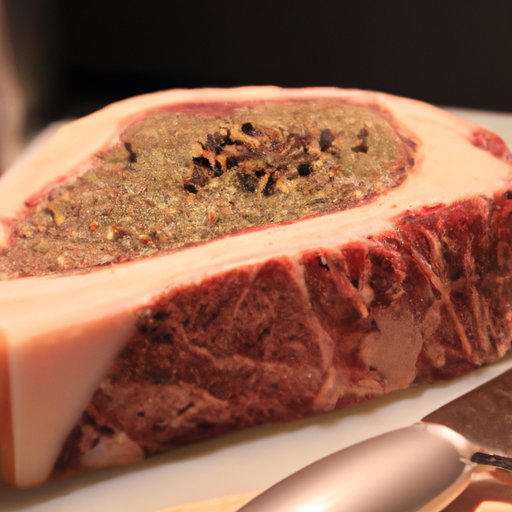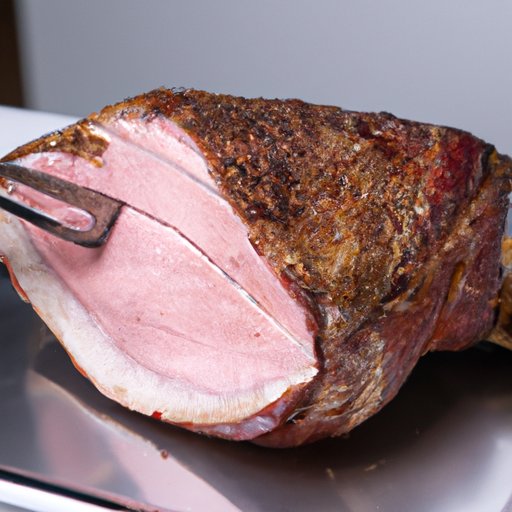
Introduction
Prime rib is a delicious and popular holiday favorite, but it can be a daunting task for home chefs to tackle such a large roast. In this article, we’ll cover everything you need to know to cook the perfect prime rib, including selecting the right cut, choosing the cooking method, seasoning, carving, and serving. Let’s get started!
The Ultimate Guide to Cooking Perfect Prime Rib: A Step-By-Step Tutorial
When it comes to selecting a prime rib, it’s important to look for a good quality cut with plenty of marbling. The marbling helps to keep the meat tender and flavorful, while the fat cap on top of the roast adds extra flavor during cooking.
There are three main cooking methods for prime rib: oven, grill, and smoker. For most home cooks, the oven is the most convenient and easiest method. Preheat the oven to 450 degrees and place the seasoned prime rib in a roasting pan. Roast for 15 minutes, then reduce the heat to 325 degrees and continue cooking until the internal temperature reaches your desired level of doneness.
It’s important to use a meat thermometer to ensure the prime rib reaches the perfect temperature. For a rare roast, remove it from the oven at 120 degrees; medium rare at 130; medium at 140; and well done at 150.
Once the prime rib is cooked to the perfect temperature, remove it from the oven and let it rest for at least 15 minutes. This allows the juices to redistribute, keeping the roast tender and juicy. Carve the prime rib against the grain into thick slices, and serve.
Prime Rib 101: Tips and Tricks for a Perfectly Juicy Cut
One of the keys to a perfectly juicy prime rib is seasoning and preparing it properly. A dry brine is a great way to add flavor and keep the meat moist. Simply rub the roast with salt and any other herbs or spices you like, then refrigerate for several hours or overnight.
Adding a marinade is another way to infuse more flavor into the prime rib. A combination of olive oil, garlic, and rosemary is a classic and delicious choice. Be careful not to over-marinate as this can lead to a mushy texture.
When it comes to seasoning, don’t be afraid to experiment with different herbs and spices. A classic garlic and herb rub is always a favorite, but spices like cumin, smoked paprika, or even espresso can add a unique twist to your prime rib.
It’s also important to prevent the prime rib from drying out during cooking. Using a meat thermometer helps to prevent overcooking and ensures the roast is cooked to perfection.
Mastering the Art of Prime Rib: Techniques and Recipes
For more advanced cooks, techniques like reverse searing or sous vide can add another level of flavor and texture to the prime rib.
A garlic and herb rub is a classic and delicious choice, but there are plenty of other seasoning options to explore. A spicy espresso rub or a tangy mustard and herb coating make for tasty alternatives.
When it comes to pairing sides and wines, there are plenty of options to complement the rich and savory flavors of the prime rib. Roasted root vegetables, creamy mashed potatoes, and crisp green beans are all classic choices. For wine, a bold red like Cabernet Sauvignon or Malbec pairs well with the rich flavor of the roast.
Serving Up a Flavorful Prime Rib: A Classic Dish for a Special Occasion
Prime rib has a long history as a celebratory meal, dating back to medieval England where it was served at royal banquets. Today, it remains a favorite for holiday dinners and special occasions.
To create a festive and memorable atmosphere, take the time to set the table and create a welcoming atmosphere. Candles, fresh flowers, and festive decorations all add to the ambiance.
For a complete holiday dinner menu, consider serving prime rib alongside classic sides like roasted potatoes, glazed carrots, and fresh dinner rolls. Finish the meal with a decadent dessert like chocolate mousse or berry cheesecake.
Prime Rib: The Perfect Main Course for a Holiday Dinner Party
Preparing prime rib for a holiday dinner party can seem overwhelming, but with some careful planning, it can be an enjoyable experience for both the cook and the guests.
When planning the menu, consider the size of the roast and how many guests you’ll be serving. A good rule of thumb is to plan for 1/2 to 3/4 pound of meat per person. Don’t forget to factor in other dishes when calculating your portions.
For appetizers, choose simple options like a cheese and charcuterie board or shrimp cocktail. Sides like roasted vegetables, creamy mashed potatoes, or a crisp salad add balance to the meal. Finish off with a decadent dessert, like a rich chocolate cake or classic apple pie.
From Shopping to Serving: Everything You Need to Know About Cooking Prime Rib
To ensure a successful prime rib meal, there are a few important steps to follow. Begin by selecting a high-quality cut of meat from a reputable butcher.
When preparing the prime rib, take the time to properly season and dry-brine the meat. Make sure to use a meat thermometer to ensure the roast reaches the perfect internal temperature for your desired level of doneness.
Don’t forget to let the prime rib rest before carving, and always slice against the grain for the best texture.
For those interested in learning more, there are many resources available online and in cookbooks to help hone your prime rib cooking skills.

Tantalizing Taste Buds: Preparing the Best Prime Rib Your Guests Will Ever Taste
Preparing a delicious prime rib is a labor of love, but the end results are well worth it. There’s nothing quite like the satisfaction of hearing your guests rave about the meal you’ve prepared.
Don’t be afraid to try new seasonings and techniques to make your prime rib your own. Whether it’s a spicy rub or a flavorful marinade, the possibilities are endless.
Lastly, we encourage our readers to share their own prime rib stories and tips. Whether it’s a treasured family recipe or a new twist on an old classic, let’s keep the love of prime rib alive and well.





